The Psychology of Interior Design for the Learning Space
The Psychology of Interior Design for the Learning Space
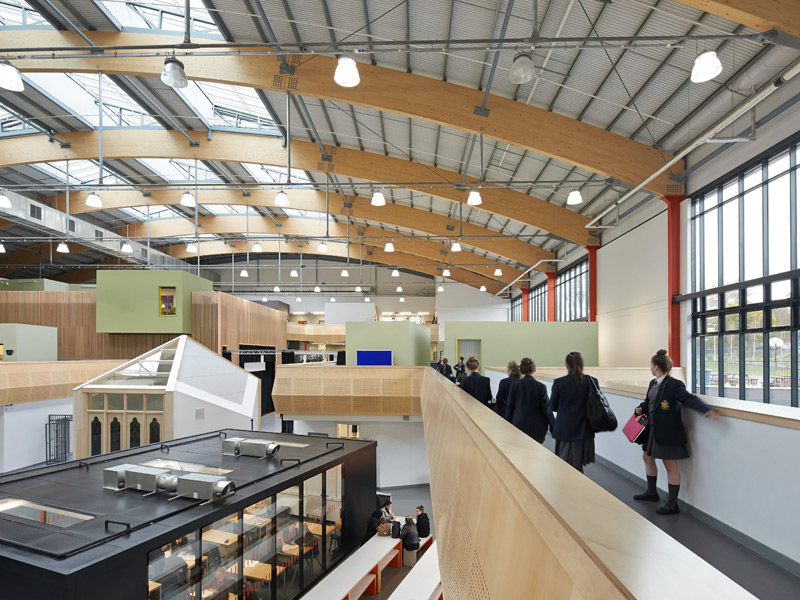
Manage FF&E specification, procurement, and product data at scale. Take on bigger projects with confidence and grow your firm with Fohlio. Schedule a demo or book a consultation with one of our account managers to explore these features today.
Albert Einstein — one of the leading intellectual luminaries of our time and an educator — once declared that he did not teach his students. “I only attempt to provide the conditions in which they can learn.” It took a few decades, but educational systems around the world are catching up to his philosophy. Interior design for the learning space now provides much more consideration for the student, providing the optimal setting not just for academic achievement, but social edification, as well.
The average age of the American school is 50 years. “Schools are one building type that we’re all familiar with because we’ve all been to school,” says Prakash Nair, president and founding partner of Fielding Nair Architects, specialists in learning space design.

Schools followed the “sage on the stage” model — that is, a classroom layout with a central platform where the teacher stands, and chairs that face it. It’s simple enough, and it worked well enough.
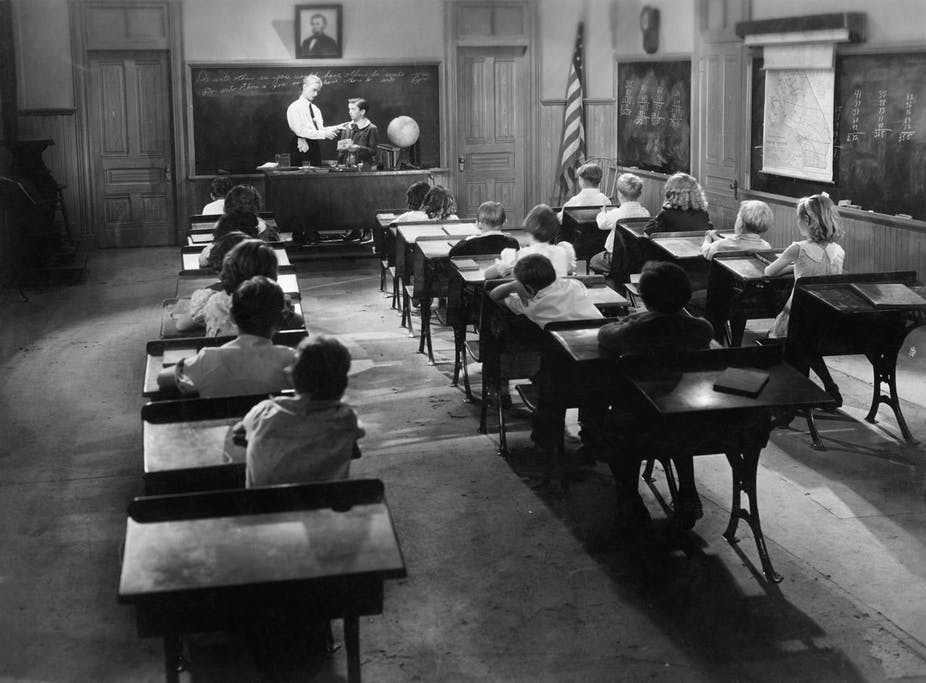
Image: The Conversation
But as neuroscience helps us better understand how the brain functions and the best ways to learn, so do teaching methods and technologies evolve. So should the learning environment.
The challenge now, according to Nair, is to imagine “what a school could be, as opposed to what it has always been.”
What Interior Designers and Architects Tend to Miss About Learning Space Design
According to teacher and former interior designer Erin Klein, architects and other design professionals often “miss incorporating the students’ ideas and opinions.”
It’s not the architect’s fault. “One of the first things architects and designers do is they have to bid for jobs that they’re interested in or clients come to them. Either way they’re consulting with the client. However, that doesn’t happen in education,” Klein says.
She further explains how architects and designers consult with administrative teams instead of students and teachers. The result is consistent with Nair’s concern: Architects end up designing what they think classroom design traditionally looks like, missing the mark entirely.
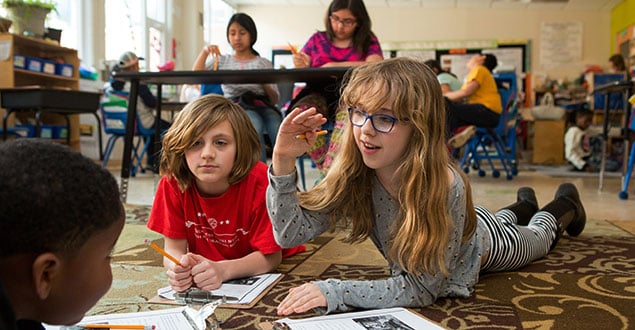
Image: Reading Rockets
Interior Design for an Effective Learning Environment
To maximize learning potential, Lennie Scott-Webber, director of education environments for Steelcase and former head of the Department of Interior Design & Fashion at Radford University, says we should create a space that can become the catalyst for change.
“When you open the door to a space, does it give you permission to act differently other than to be behaviorally conditioned to ‘sit and sit’ or ‘stand and deliver’? If the space doesn’t give permission to change, then it’s too easy to revert back to what we know,” Scott-Webber says.
So what does an effective learning space look like? While there’s no single classroom design that works for all, there are a few basic tenets to apply.

Curved, Open, and With High Ceilings
According to Oshin Vartanian, Adjunct Professor of Psychology at the University of Toronto Scarborough, a part of the brain’s core emotion network is activated when viewing rooms with a curvilinear design. They were regarded as beautiful and pleasant. Rooms with high ceilings, on the other hand, stimulated “visuospatial exploration”; that is, they made people pay more attention.

Notre Dame Catholic College. Sheppard Robson say the cost-effective solution was the result of an all-party transparency process that was maintained throughout the design and delivery process. ‘From the start, all parties (including the client, the end-users, contractor and designers) were clear that the budget was very constrained,’ explains Jones. ‘But the finished building must be seen as an asset to its community and a positive investment.’ Image: DesignCurial
What does this have to do with learning? Emotional connections are crucial to the learning experience. So is paying attention. Vartanian and his team were able to show that a certain type of space is able to encourage both.
In contrast, enclosed spaces are detrimental to learning as they can increase cortisol, the stress hormone.
Of course, design can be constricted by budget, so creative solutions may be necessary. An old-school, standby solution? “Mirrors can transform small spaces,” says Camille Overmeer, interior designer at The Camellia. “Placing them across from a window gives the illusion of multiple windows, plus it reflects the natural light.”
Comfortable Classroom Design Does Not Mean Coddling
Time and again, it’s been proven that students need to be comfortable in order to learn effectively. It’s just common sense — and no, it doesn’t mean shielding students from the harsher realities of the outside world.
Jeremy Mettler, a social studies teacher at Batavia High School, says “The reality is, if you’re sitting in an uncomfortable chair or you’re distracted by glare, you’re focusing on the source of the discomfort rather than the learning. The distraction is a stress, and if you’re stressed, you’re not learning.”
Comfort in a learning environment can be as simple as adequate lighting, proper acoustics, and well-regulated ambient temperature.

Nearness to Nature, and Lots of Natural, or Near-Natural Light
In the 1990s, school districts across America were struggling to find solutions to dismal student performance on standardized tests. They experimented with different curricula, different teaching methods, new textbooks, better trained teachers, smaller classes, and more.
An architecture firm in California, however, scrutinized a different element altogether: light. The question was, could the problem be partially solved by improved lighting?
The answer surprised them. In a rigorous study involving 21,000 students, it was found that those who studied in “classrooms with more natural light scored as much as 25 percent higher on standardized tests than other students in the same school district.”
It supported anecdotal evidence that architects had been citing all along: “Children learn better under illumination from skylights or windows, rather than bulbs.”
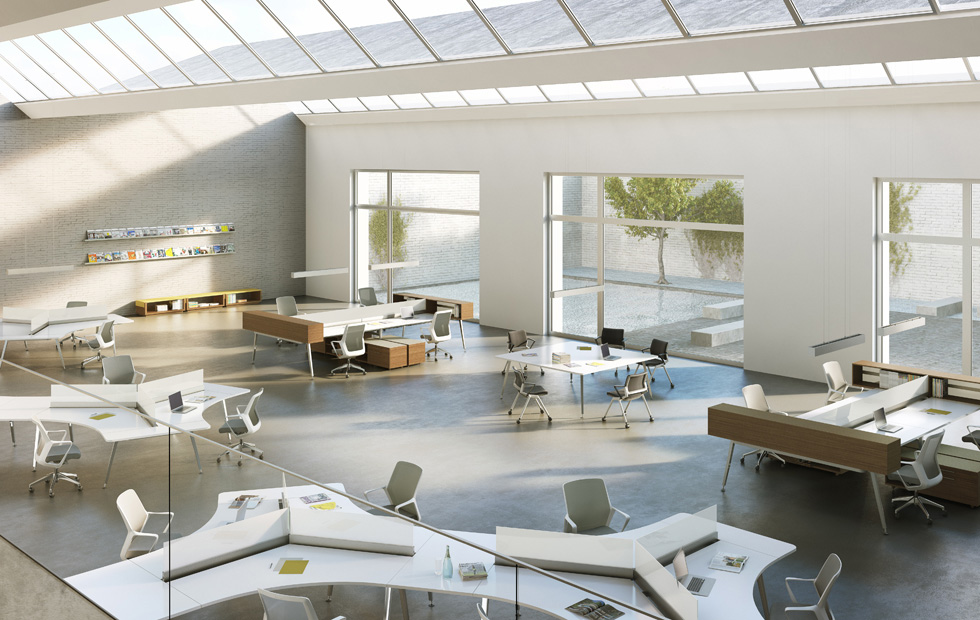
Image: West Windsor – Plainsboro High School South
One of the authors of the study, Lisa Heschong said they were “completely taken aback at the magnitude of these findings … It’s an eye-opener.”
While the study did not explain why students in classrooms with more natural daylight performed better, Heschong had a few theories. “Kids see better, or teachers see better,” she said. “It may be that teachers feel better, are more motivated by daylighting.”
Classroom design that incorporated nature also had a vastly positive effect. While countless studies have shown that office employees are more productive when they are near a natural element, students are no different.
Studies show that simply incorporating plants in the classroom layout improves the grades of middle school students, reduces sick leave in primary school students, and makes students and staff feel more comfortable and satisfied, no matter their age.
Zoning and Flexibility Are Not Just for Coworking Spaces
In coworking spaces, “I” and “we” spaces are equally important: the latter for collaborative effort and socializing, the former for focused work. Diversity in seating arrangements also helps people break out of ruts and get fresh perspective.
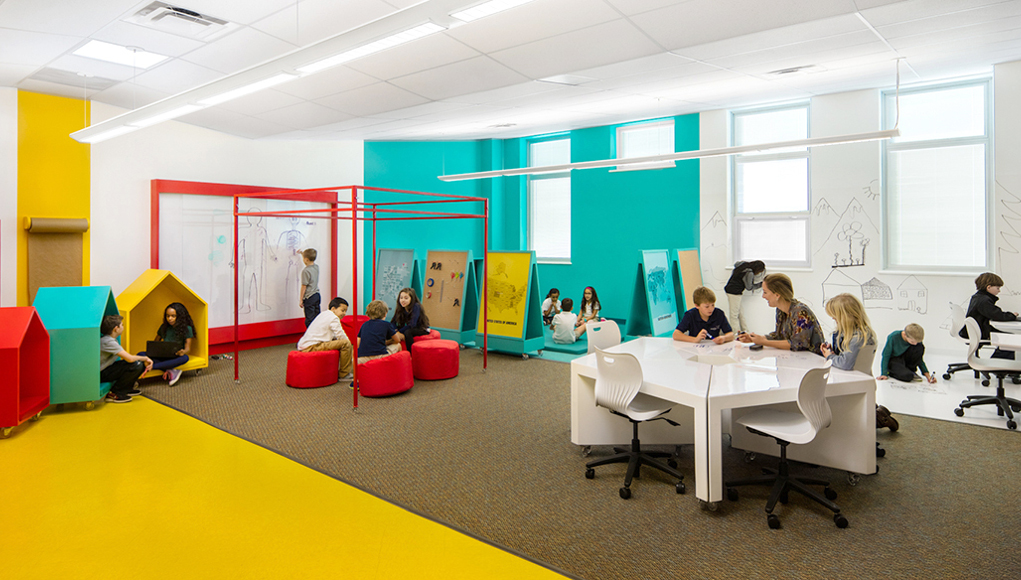
Different zones for different activities. Image: Danish Kurani via Getting Smart
In a learning space, these different zones and the flexible seating are no less important, and the reasons are not that different. In Pennsylvania State University, for example, the HUB-Robeson Center has a grand bleacher staircase ideal for encounters, interaction, and collaboration. Bradley University in Illinois provides a more unique take: collaborative study tables on landings attached to a steel staircase.
Students “are looking for open, fluid designs in the classroom. Instead of a static classroom filled with individual desks, designers should look for ways to create breakout spaces. Educators from Edutopia recommend arranging desks and tables to create nooks and designated spaces specified for different areas of study.”
As well, “Desks, chairs, tables, whiteboards; virtually any piece of classroom furniture can and should have the ability to be moved around in order to adapt to the students’ needs.”
Manage FF&E specification, procurement, and product data at scale. Take on bigger projects with confidence and grow your firm with Fohlio. Schedule a demo or book a consultation with one of our account managers to explore these features today.
European trends in interior design
European-style interior design is trending right now because of its wonderful advantages. If you’re feeling tired of the decoration style you already have at home and are searching for some inspiration, European interior designs could be great options. However, to achieve this style of decor in your home, you should know which elements will be necessary to change your environment completely.
If you want a European interior design in your home, keep reading to get more information related to this style.
European interior design

Interior design has become all the more relevant in recent times since it allows for the creation of functional and disciplined environments. It is also the best option for maintaining order and cleanliness. The latest trends in Europe for interior design , it is important to know, take inspiration from the French Baroque style, the English Victorian era, the Italian Renaissance, and Greco-Latin Classicist decorations.
Each of these styles can be applied when decorating homes with a European touch. Similarly, most of these designs overlap with each other because of the common origins and culture prevalent in European homes. However, so that the European style complements your home beautifully, it is important to first determine which decorations will maintain harmony in your spaces before taking action.
To begin, focus on the basic features of European interior design:
- European-style interior design is a mixture of contemporary and classic elements. European interior design is notorious for its play of contrasting colors, so combinations such as white with red will be an excellent choice.
- Likewise, in this decorative style, comfort and simplicity are essential so that families can enjoy a peaceful atmosphere.
- Sobriety is another characteristic of this interior design, especially in Northern Europe, where symmetry and order are the protagonists.
- The European home also differs from others in its multiculturalism and definitely reflects a rich history.
What are the best options in European interior design?
Nowadays, European interior design trends follow both classic and modern trends. That is why, when creating a European-style environment, it is important to have knowledge of the different styles that can refresh your space:
Scandinavian style

The Nordic-style interior design has become one favorite to revamp the decoration of a home. Similarly, we could say that simplicity is one of the key characteristics of this style that cannot go unnoticed.
The Nordic design achieves a modern look while allowing for the addition of functional elements. This is why a Nordic-style home will have a lot of versatile, multi-functional furniture. Of course, regardless of whether or not there is a lot of furniture, they will be arranged in an organized way.
Natural light is a must in this European style, which is why heavy curtains will not fit in this type of environment. The best option is to place wooden blinds on the windows.
Now, flooring can also have a Scandinavian touch, and wood is the right material for it. As a tip, it is best to opt for neutral colors such as white to give your home a more spacious look.
Italian style

When talking about European-style interior design , we cannot fail to mention the famous Italian style. Aesthetics are very important to achieve this type of design. Furthermore, wide spaces are also essential since Italians are very homey. To them, sharing with family and friends is paramount.
Likewise, each piece of furniture included in the interior design must fulfill a function and complements a few central pieces so as not to detract from their protagonism.
As for the accessories, we recommend that they be few so as not to detract from the spaciousness of the room. Likewise, it is important that an Italian-style interior space looks completely tidy.
A neutral and earthy color palette is ideal for this type of interior design, as well as wall art that matches the homeowner’s preferences.
French style

If we are talking about refined decoration, the French style of the eighteenth and nineteenth centuries is the main character. To achieve the poise of the French style, the color palette should be subtle, so it will be a good idea to choose shades such as white, pink, and light blue.
Simplicity is also part of this design, and that is why within the decor you can see few ornaments. Also, if you want to add decorative elements to the traditional French style, adding some candlesticks would be an excellent idea.
This type of European-style interior design differs from others with its contrast of light colors; besides that, it also can add some modern elements to create a more contemporary atmosphere without detracting from its elegance.
German style

The German style is also often used in homes where elegance prevails. This style is also innovative and contemporary, which is why materials such as concrete and granite are prevalent in the flooring. Besides elegance, German-style homes never lack brilliance.
For kitchens in this style, the use of stainless steel and glass decorative elements is common. Likewise, one of the most peculiar characteristics of this interior design is that Germans install large beer coolers to contribute to the chic look of their homes.
For this reason, like other European styles, it is very common to have a traditional bar if there is sufficient interior space.
English style

Innovations in European-style interior design are very celebrated and English style is among them. In this style, one of the most important elements is the furniture, especially those that have a lot of curves.
For example, the Chester sofa, oftentimes upholstered in light colors, is one of the most used pieces of furniture to develop a harmonious atmosphere.
Likewise, in this type of interior design, textiles such as leather and cotton as well as walls in gray or brown tones stand out. Wallpaper and tapestries are also very common strategies for adding quality decoration to the walls.
You can add a fusion of European styles to your interior design.

It is likely that you feel drawn to various elements of European style interior design . If this is the case, you have the option to blend interior designs and unite different European styles.
Mediterranean design is an excellent option since it can include elements of Italian, Spanish, and Nordic styles. One of the most outstanding characteristics of this design is the strategic use of light within a home in order to cultivate a pleasant atmosphere.
Similarly, freshness and intricacy can also describe this colorful style that attributes more vitality to a space. Likewise, so that natural light can pass into the interior space, there should be light curtains that match white or other light-colored walls.
Other colors that can complement the Mediterranean design are ocher, aquamarine, and olive green. Apart from the colors, there are also materials that have become the protagonists of this design, and wood is the main one.
You can also use wood in flooring, furniture, and even ceiling beams for an exceptional ambiance.
Another design that is inspired by different European styles is the modern style, and renowned designers from Germany and Italy have contributed to it. To achieve a quality modern design, simplicity must prevail, including key elements such as lamps and furniture with straightforward shapes.
Similarly, natural light is also an essential element, and colors such as white and gray are used to make the environment look more spacious. We must consider that it is unnecessary to combine more than three colors to achieve the right modern design. Also, to follow the European trends in interior design , simply adding materials such as metal, glass or wood will be enough.
The European style in interior design creates pleasant environments.

There are many notions about European-style interior design , no matter where you are in the world.
You don’t have to be in Europe to enjoy the benefits that each of these styles can bring to your home.
If you wish to renovate your house with some of the European styles, Erisa is home to a group of professionals ready to renovate your interior design according to your preferences.
Environmental sustainability and its role in interior design
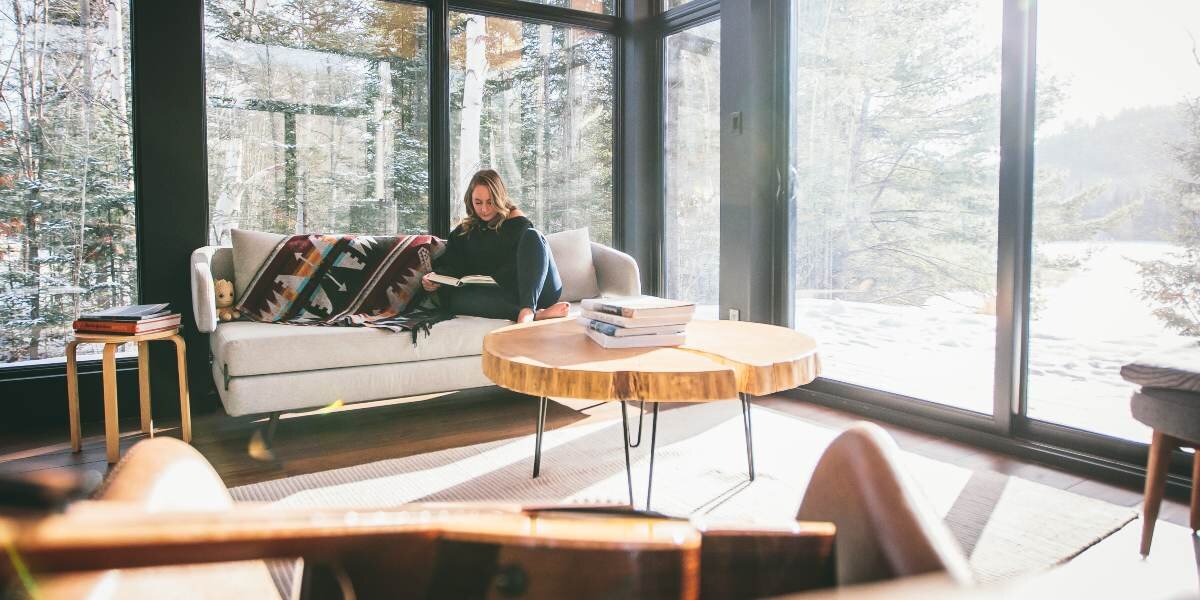
Maybe it’s time to consider a more nature-based interior design in real estate, with concepts such as energy and water efficiency, waste reduction and recyclable materials implementation – not only for reduced environmental impact but for the positive impact on human health and wellbeing.
Biofilico designs for people, planet and your profit! Our actions address human health, environmental sustainability, and financial gain.
As the world becomes increasingly urbanized, our lifestyle conveniences and wishes are increased, while access to nature and green spaces decreases. As a result, we have a fundamentally disconnected evolutionary flow, with many problems (mainly diseases) tightly connected to it.
In further text, you will find more information concerning the importance of environment and sustainability, and its impact on our life through interior design and places we live in.
What is environmental sustainability?
When we talk about environmental sustainability meaning to address all aspects of our lives – we need to include everything, from eco-homes, the sourcing of our supplies, renewable energy, environmentally conscious communities until low impact furniture and even clothing.
But what is environmental sustainability actually?
The meaning of environmental sustainability has many definitions used by green groups, businesses and even politicians and activists, but the concept and principles of sustainable development were first introduced in 1987, in the “Our Common Future” report, prepared for the World Commission on Environment and Development.
Why is environmental sustainability important and needed
The importance of environment and sustainability has been recognised for all the damaging factors that can be caused by individuals to our environment. We must all take care for each other – humans need to look after the plants and animals we share our planet with, of the air we breathe, our rivers and oceans we consider continental boundaries.
Looking after environmental health is crucial for ensuring a green future and healthy lives on a healthy planet. That is why looking after our environment is something we must all be a part of.
There are many environment development and sustainability projects, on a large and small, local, or national/global level.
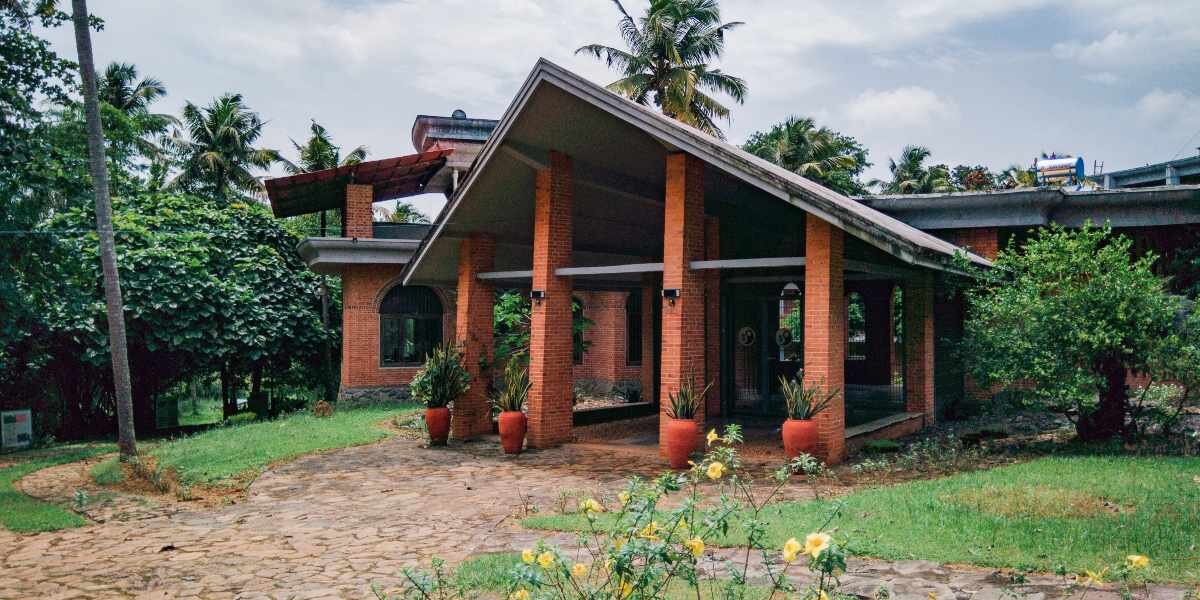
How environmental sustainability affects social responsibility?
A relationship of people and spaces is based on psychological and psychical parameters, and has great implications on the improvement of life quality. Targeting social welfare and happiness through environmental sustainability is a measure that results in higher levels of employee creativity, motivation, and wellbeing.
The most important criteria to save and heal the planet is the selection of materials that are going to be used in the process of building and decorating. Every material has its function, so materials used in hospitals and shopping malls should be different due to the sterilisation needs, but it is very important to select the materials with maximum potential to reduce waste.
The embodied energy (energy needed to produce some material) is also an important factor when choosing a sustainable material for a home or some public space.Concrete, steel and the plastics are higher in embodied energy than some more natural elements like stone or timber.
Recycling potential is an important factor in the field of waste management. Moreover, the level of emission of toxic gases (in production and use) should be considered as an important step to go for more traditional, but highly sustainable techniques in construction .
Decreasing the amount of global waste leads to creating new technology in order to generate electricity from the plantation.
Interior environments are places where all human needs are exposed. They are the most intimate spaces where our health, physical and psychical, is affectable by many bad factors we have inflicted upon ourselves.
Environmental sustainability in business
Taking the initiative in creating a more environmentally conscious company culture through eco-friendly policies is a bold move, even if it starts with the elimination of plastic straws and paper in an effort to reduce plastic waste.
Developing a corporate environmental responsibility begins on the level of your workforce. It is crucial (especially for young) people to believe in the vision and practice of environmental sustainability, changing their habits in the office , in order for the mission of sustainability to be carried out accordingly.
Environmental Sustainability and Interior Design Elements
Interior design is a profession subjected to the context of human needs and the many different levels of their satisfaction. The interior space is made to satisfy the needs of security, surviving and achieving higher self-esteem.
Recent studies have shown the need for environmental health and sustainability within our living spaces, and the obligation for the niche to be included and survive. This is why the practice of interior design elements is looked upon as a context of sustainability.
In the environment development and sustainability principles, the links between inequality, poverty and environmental degradation were recognized, thus the elements of their improvement were needed to support communities and to find a way forward for a fairer world with less damage to the environment.
So the environment development and sustainability concept met the needs of the present, without compromising the ability of future generations to live in a better world.
Environmental sustainability in interior design is referred to all the systems and materials integrated into one whole purpose (for example into healthy buildings spaces for inhabitation), minimizing negative impacts on the environment and occupants, while maximizing the positive health, economic and social life cycle.
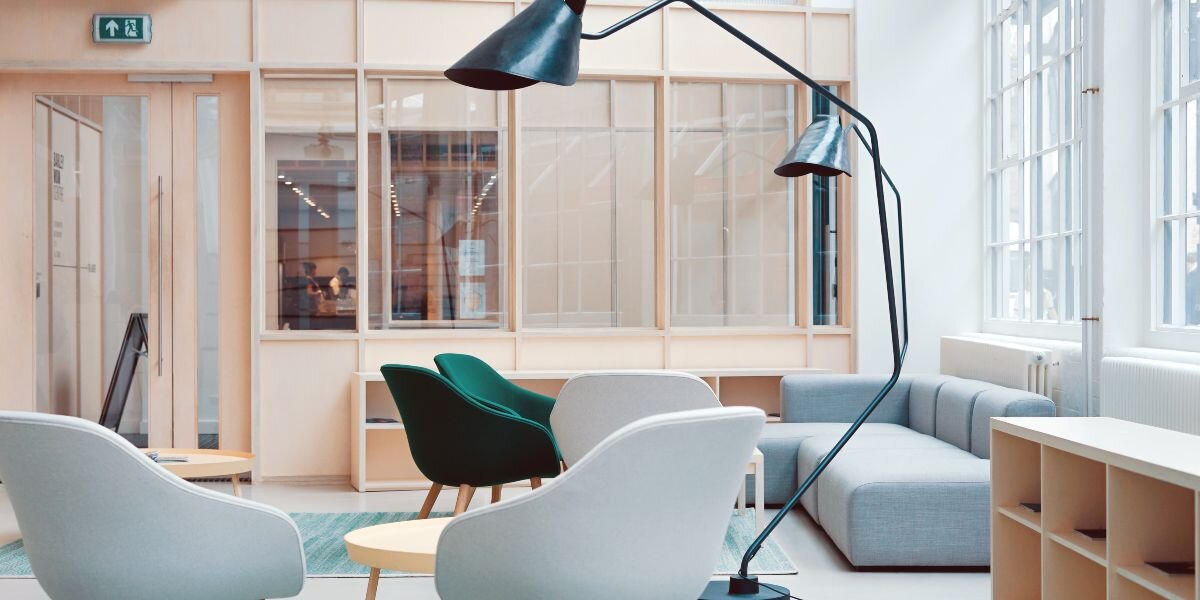
Environmental sustainability in interior design and the Planet
Issues of environmental development and sustainability are concerns like whether environmental resources will be protected and maintained for future generations. Limiting consumption of nonrenewable resources, and naturally, shifting to renewable resources and avoiding excess pollution damaging to our health and the earth’s atmosphere.
The biggest problem now is making an economic decision based on the insight of the long-term consequences and making integrational decisions to target economic and social welfare.
The long-term health of ecosystems
Principles of sustainable development protect the long-term productivity, and health of the resources that are going to be used in the future, meeting the economic and social needs.
Making decisions to protect food supplies, farmlands and fishing stocks, species diversity and ecological structure, we ensure the health of our future generations and the loam of our lands.
Prevention of the man-made global warming
Water shortages, extreme weather events, excess temperature and all the other problems have been predicted for the future generations to face because of the deterioration, usage of harmful materials and substances – factors that could make living in some parts of the world very difficult, if not possible.
Intergenerational decision making
When making large economic decisions, we should focus on the implications for the future, not just for the present moment. For example, using coal as energy gives a short-term benefit of cheapness, but the pollution weight is immense for future generations.
Renewable resources
Diversifying energy sources from nonrenewable into renewable and sustainable ones that, again, do not rely on non-renewable resources is one of the main concerns that should be met in the future. For example, most popular solutions are solar and wind power generating windmills, panels and skylights.
The willingness to create sustainable environments should be primary met and fulfilled within workplaces and private home interiors. Interior designers have an essential tool in their hands to lead sustainable environments and create consciousness in sustainability.
Interior design elements are major tools in creating long term environmental sustainability, with elements of natural resources, sustainable fabrication, manufacturing, and installation, all the way up to sustainable use, reuse, recycle and final disposal.
Source https://www.fohlio.com/blog/psychology-interior-design-learning-space
Source https://erisaprojects.com/european-trends-in-interior-design/
Source https://biofilico.com/news/2020/9/3/environmental-sustainability-and-its-role-in-interior-design